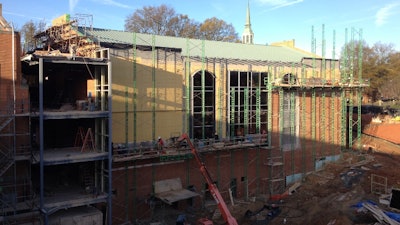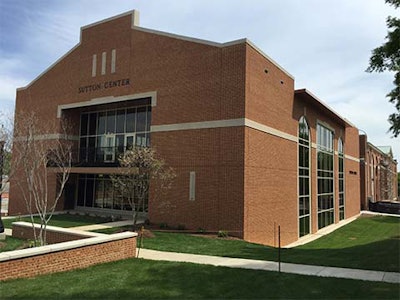![[Photo Courtesy Max Floyd]](https://img.athleticbusiness.com/files/base/abmedia/all/image/2016/07/ab.Screen%20Shot%202016-07-15%20at%202.53.31%20PM.png?auto=format%2Ccompress&q=70&w=400)
Whether it is doing research in a laboratory, playing in an athletic contest or building a recreation center on a college campus, the old saying applies; “It is not how you start, it is how you finish.” The final three steps in a construction project are extremely important and will determine how you finish. Even though you may have done well in steps 1-6 (1. choosing the architect 2. performing a needs assessment 3. programming the spaces 4. choosing a schematic design 5. weighing in on design development and 6. understanding the construction documents), steps 7, 8 and 9 will be the final opportunity for you to have a hand in the non-operational plan. When the plans and specifications are completed, the project is ready for bid.
In this article we’ll discuss bidding, your role during construction and the final closeout/post occupancy.
General contractor and subcontractors
There are two major bid areas. The first is the selection of the general contractor (GC). The GC will usually be brought on board immediately following the schematic design phase. When the GC is brought on early in the process, if they are in a general contractor At-Risk situation, they will be able to have a major voice in the constructability of the project, providing needed expertise during design development and the writing of the construction documents. In a university setting there is usually a list of general contractors in the area that will be sent an RFP (request for proposal) concerning the building project at hand.
Because of technological advancements and specialization in today’s construction world, the general contractor’s work is confined to the trades that the company performs directly, usually without subcontracting. Much like the selection of the architects, the selection of the GC will be substantial in cost, often approaching 10-12 percent of the entire project cost. Typically the architectural fees will be 6-7 percent. The largest costs will come from the subcontractors themselves, with the total coming in over 80 percent of the project cost most of the time.
Bidding
The goal in the bidding phase is to get the best-qualified subcontractor to build your facility at a fair price. Bidding is the process of receiving competitive prices for the construction of the project. The bidding process includes: bidding and advertising, opening and review of the bids and awarding of the contract. The bid documents involved in bidding include the invitation to bid, instructions to the bidders, the actual bid form, possibly a sample of a bid or contract form and the drawings and specifications.
All bids on large contracts like work on an athletic facility should come with some type of performance bond, ensuring that the subcontractor will perform the work as designed at the price bid. This ensures that the bidders are sincere in their prices. With complex projects, it is desirable to schedule a pre-bid conference to explain the design and bidding process to the prospective bidders. This is an important time for the subcontractors to ask questions seeking clarification on any of the specifications in the package. Good subcontractors will be meticulous when it comes to measuring dimensions and counting material quantities. Before a good bid package is submitted, each subcontractor will be given access to the Project Manual also known as the Specifications Book or “Spec Book.” In addition to the Spec Book, there will be complete set of drawings for each subcontractor to study before submitting the bid.
The time and place of the receipt of the sealed bids must be clearly shown on all bid packages. No late bids should be received, for in so doing the entire bidding process is compromised.
Opening and review of the bids
At the bid opening, a technical analysis is performed to make sure that the bids are complete, the prices are reasonable and the subcontractor is able to do the work. Most contracts are awarded to the lowest qualified bidder. Sometimes, however, the low bidder may not have the expertise or manpower to do the work, and the work is given to the next qualified bidder. If a bid is really low, the bid reviewer usually contacts the firm to ask to check the quotation. If you do not do this and the low bid is taken, a subcontractor may make every effort to reduce costs by cutting every corner they can; such as using cheap materials, doing poor work and in general turning out an inferior job.
If you are in a situation where you are not required to go with the lowest bidder, the selectors still must have compelling reasons for the choice.
The parameters for the awarding of bids both for the GC and the subcontractors who will be doing the majority of the work varies from institution to institution. As the future operator of the facility who knows the bid award process, such knowledge will only help as you go through the all important construction phase.
Construction
The goal is to build the building in accordance with the construction documents — to be on budget, on schedule and with minimal change orders.
Though the number of phases may vary depending upon the magnitude of the project, all of the following steps will be required during construction:
Change orders
If changes have to be made, the sooner they are, the better. Though extreme, the following tells how change orders can affect a project:
- Changes during design phase: $1 in cost
- Changes during construction documents: $10
- Changes during bidding: $100
- Changes during construction: $1,000
- Changes after building completion: $10,000
Pre-final inspection and preparation of the punch-list
A punch list is a list of work that needs to be done by the contractor prior to final inspection. All items that are not completed according to the specifications are included on the list. The punch list is then agreed upon and signed by all affected parties. The contractor must then correct and/or finish all of the items on the list.
Here is a list of potential deficiencies at the end of the construction period: Aesthetic concerns, quality of construction/finishes, code requirements not met, levels and plumbness were apparent, structural deflections under load, engineering systems (structural, mechanical, electrical) and building systems – walls, roof, windows and floors and maintenance requirements.
When the punch list is completed, it is time to call for a final inspection.
Final inspection and acceptance of completed project
Assuming that all of the work has been completed, with systems working properly as shown on the plans and described in the specifications, the project will be accepted and officially turned over to the operator.
Most large projects with performance bonds included require the contractor to replace or repair any defective or damaged items during the time covered by the bond. Typical items would include leaking roofs, infiltration of ground water into sewer lines, puddling of water in parking lots, etc.
At all of the closeouts, all owners need to be present as each look at each item differently and can catch missed items.
Post-occupancy
The goal of the post-occupancy review is to ensure that minor omissions are corrected and that any defects that surface during the maintenance period are corrected. Usually there is a one-year warranty period as noted in General Conditions Contract. At the end of the one-year warranty period there will be a final inspection/meeting.
Once construction has begun, the following is a list of the things that should be taking place:
- Create a chronological and historical rendering of the project in both written and audio/visual formats. It should begin at ground breaking and cover the course of the entire project through the first anniversary
- Develop a thorough working knowledge of all contract documents, the specifications book and any shop drawings. Strive to gain a thorough knowledge of change order procedures and limitations.
- Continue to work closely with the architect, the project manager and site project foreman/superintendent and never be afraid to critique. A comprehensive working knowledge of the contract documents is the best tool the user has available, and will only serve to grow and improve the facility management process. Attend all construction progress meetings.
- Finally, involve your staff and plan for opening day. Create a relationship and operating manuals at least two months before opening day.
Every project has its own story. Every project has its own requirements and protocols. Every project has its own struggles, obstacles and mountains to climb. Omissions and errors are part of the game.
However, if you, the administrator charged with overseeing the project, know what steps to take from concept to completion, you will be ahead of the game.
The one who knows the steps in the plan will be the one who can guide the operation of the plan.
Good luck with what stands in front of you.



































